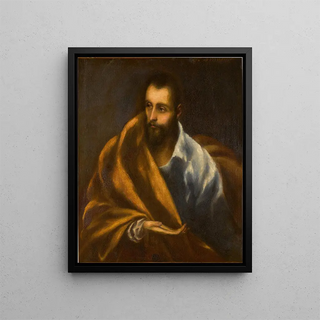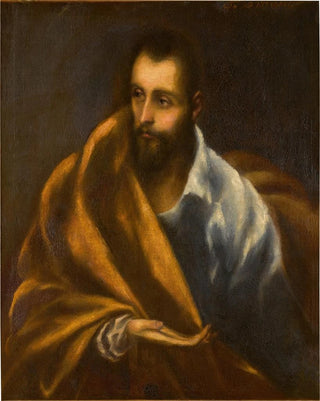Art print | Saint Jacques le Majeur - School of Domenikos Theotokopoulos known as El Greco


View from behind

Frame (optional)
The art print "Saint James the Greater" by Domenikos Theotokopoulos, better known as El Greco, is an iconic work that transcends the simple artistic framework to become a true spiritual exploration. This piece, depicting the patron saint of Spain, embodies the fusion between religious tradition and an innovative approach to form and color. Through this art print, the artist manages to capture the very essence of devotion while offering a unique vision that invites contemplation. The work, with its vibrant palette and flowing lines, immerses us in a universe where the sacred and the profane meet, prompting us to reflect on our own spirituality.
Style and uniqueness of the work
El Greco's style is immediately recognizable by its intense colors and elongated figures, which seem to float in a mystical space. In "Saint James the Greater," the saint is depicted with an expressiveness that transcends realism, illustrating passion and spiritual commitment. The drapery of his garment, with rich and contrasting tones, bears witness to a technical mastery that is uniquely his own. The light, omnipresent, highlights the features of the saint's face, emphasizing his determined gaze and dynamic posture. Every detail, every brushstroke, contributes to creating a vibrant atmosphere that draws the eye and captivates the mind. This work, both religious and deeply human, reminds us that art can be a powerful vehicle of emotions and reflections.
The artist and his influence
Domenikos Theotokopoulos, born in Crete and having found his path in Spain, is often considered one of the pioneers of Mannerism. His artistic journey is marked by an incessant quest for innovation, blending Byzantine influences and Italian Renaissance. El Greco managed to create a personal style that subsequently influenced many artists, both contemporaries and followers. His bold approach to forms and colors paved the way for artistic movements such as Expressionism and Fauvism. Through "Saint James the Greater",

Matte finish

View from behind

Frame (optional)
The art print "Saint James the Greater" by Domenikos Theotokopoulos, better known as El Greco, is an iconic work that transcends the simple artistic framework to become a true spiritual exploration. This piece, depicting the patron saint of Spain, embodies the fusion between religious tradition and an innovative approach to form and color. Through this art print, the artist manages to capture the very essence of devotion while offering a unique vision that invites contemplation. The work, with its vibrant palette and flowing lines, immerses us in a universe where the sacred and the profane meet, prompting us to reflect on our own spirituality.
Style and uniqueness of the work
El Greco's style is immediately recognizable by its intense colors and elongated figures, which seem to float in a mystical space. In "Saint James the Greater," the saint is depicted with an expressiveness that transcends realism, illustrating passion and spiritual commitment. The drapery of his garment, with rich and contrasting tones, bears witness to a technical mastery that is uniquely his own. The light, omnipresent, highlights the features of the saint's face, emphasizing his determined gaze and dynamic posture. Every detail, every brushstroke, contributes to creating a vibrant atmosphere that draws the eye and captivates the mind. This work, both religious and deeply human, reminds us that art can be a powerful vehicle of emotions and reflections.
The artist and his influence
Domenikos Theotokopoulos, born in Crete and having found his path in Spain, is often considered one of the pioneers of Mannerism. His artistic journey is marked by an incessant quest for innovation, blending Byzantine influences and Italian Renaissance. El Greco managed to create a personal style that subsequently influenced many artists, both contemporaries and followers. His bold approach to forms and colors paved the way for artistic movements such as Expressionism and Fauvism. Through "Saint James the Greater",






